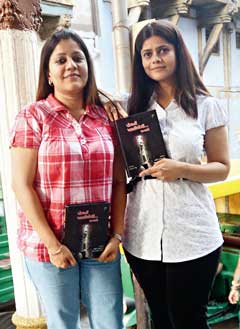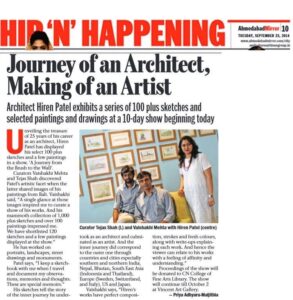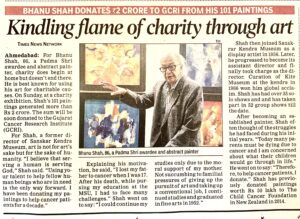
Pol Ni Khadki E Thee, a 14-chapter narrative by Priya Adhyaru-Majithia and Parthivi Adhyaru-Shah documents life in the pol from pre-independence period to 2002
How did the walled city look like while it was under curfew? The word curfew conjures up images of fear, dark nights, eerie silence, chaos and anxious minds of the older generation. The present generation, on the other hand, only has a few questions to ask. Pol Ni Khadki E Thee captures “moments from different time zones during which the walled city of Amdavad was under curfew”.
The book focuses on experiences from pre-independence to post independence days until 2002, the year when the city saw the barbaric riots. While city dwellers have forgotten the fear and chaos following the curfew, the book brings you experiences and memories of the walled city with first hand narratives of pol residents.

Here are some translated excerpts…
CHAPTER 1 – OTALAA PARISHAD
Conversation between Ashutosh Bhatt (resident of Khadia) with Ramesh Shukla, (NRI from US who is visiting Ahmedabad with his family after three decades)
“Akhadas have been replaced by high tech gyms. And we listen more to Bollywood numbers and item songs instead of patriotic songs at nooks and corners of the walled city. Yes, my friend, our Amdavad city has changed for sure, however, its spirit is still alive. It is dormant but not dead,” says Ashutosh Bhatt.
Shukla responds, “No, I do not agree. Where do we see the spirit of sportsmanship that our old games cultivated in us? Our old games maardadi, kitiketi, dondon, aatapaata, pagathiya, kabbadi, nagaolchu…this generation perhaps does not even know these names, alas.”
Bhatt abruptly interrupts. “You are right. The young generation does not know these names because we have failed to pass on that rich heritage of old games to them. And yet it is not late. If we still attempt to enliven their interest, they too will love them. You see, they still love fafda, jalebi, cutting chai, folk dances and tunes of garba.
The spirit of Amdavad is alive deep within those women who make colours at home before festival of Holi, in those who make rakhis, fly kites, within families who still wear Gandhi topi and take down accounts on festival of Diwali, those young women who adore wearing Amdavadi sarees and flaunt patolas… .”
CHAPTER 11 – BHAICHARO
(BROTHERHOOD)
The chapter profiles a couple, Yasmin and Razib. Razib was taken into custody as a suspect after Godhra’s incident. Yasmin was pregnant with twin babies. The story says how Shankerlal – just an acquaintance of Yasmin’s neighbour adopted her as his own daughter and supported her for 10 years till Razib was released in 2012.
Time – March 2012
Riyaan and Tasmin were now 10 years old. The litigation of Godhara kaand was still on. While the legal proceedings were reaching its conclusion, it was found that some suspects who were imprisoned since last decade were innocent. They rectified their official error by releasing few of the suspects.
Razib – frightened, tired – hurriedly reached Shahalam and met his neighbour Rustambhai. They met after a decade. Rustambhai took him at Shankarlal’s place. They rang the door bell. Yasmin’s daughter opened the door. She ran backwards as she failed to identify these strangers. She said, “Ma aap dekho, koi hai.” Shankarlal sat inside watching TV – his favourite evening pastime. Yasmin approached the door.
Their eyes met. In the last decade, Yasmin had gone to visit Razib at the jail only once, that too he requested her not to come again and not even mention to their children where their father is. Yasmin had just said to her children Riyaan and Tasnim that their father was alive and would surely return to them ‘one day’.
And this day was destined to become that ‘one day’. Razib had finally returned home. Yasmin silenced by his tears could hardly utter a word. She shouted for her kids. Her voice trembled, vibrated, was heavy and its tone, pitch and emotive appeal as if alerted all. Shankarlal jumped out of his seat and was at the door – quite a sudden and swift move for the elderly though.
“Baba yeh Razib hai,” Yasmin said to Shankarlal pointing at her husband. Rustambhai had to go inside and drag the kids out towards the door as he said, “Bachho, ye tumhare baba hai.”
Razib and Yasmin both dissolved in bursts of tears. Rustambhai embraced Shankarlal. Kids stood there, unmoved, watching the scene with wide open eyes.
The listeners who listened to this tale of reunion – while they sat at the entrance of the pol’s haveli – couldn’t hold back their tears. They felt as if Lord Ram is being reunited with Maata Sita.
The book by Parthivi Adhyaru-Shah and Priya Adhyaru-Majithia was released on May 7 at Ahmedabad National Book Fair by scholar and writer Rajendra Patel of Gujarati Sahitya Parishad.
The report appeared in Ahmedabad Mirror on May 7, 2013


